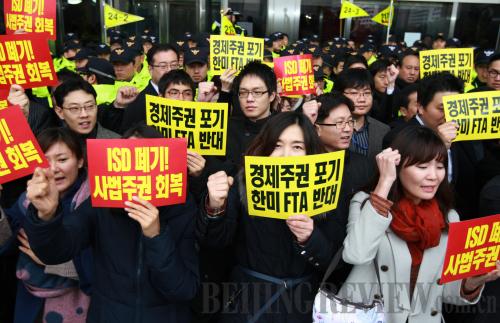|
 |
|
RESISTANCE: South Korean protesters demonstrate on November 22, 2011, in Seoul opposing the U.S.-South Korean free trade agreement (XINHUA) |
"Change" was a theme that Obama used during his campaign for the presidency. Politically, Obama's high-profile "return to the Asia-Pacific" is intended to highlight his differences with his predecessor. The Asia-Pacific policy of the Bush administration was considered one of the few remarkable points of his diplomacy. Even so, Democrats criticized Bush when some ASEAN countries complained that the Bush administration had overlooked the region.
That's why Obama's "return to the Asia-Pacific" started from ASEAN. Without a doubt, once it made progress in Southeast Asia, the United States would expand its influence in other parts of the Asia-Pacific region. Over the past two years, Washington has used its influence from the Korean Peninsula to the South China Sea and the Diaoyu Islands.
China, of course, is a factor the United States has to take into consideration when drafting its Asia-Pacific strategy. China's growing influence in the Asia-Pacific is often seen as obvious proof of U.S. decline in the region and a good reason why Washington needs to adjust its Asia-Pacific policy. But that doesn't mean the United States regards China as its rival.
The development of Sino-U.S. relations in recent years shows the United States has not defined China as a foe or a threat, but as an opportunity or a partner. While partly aiming to cope with China's rise, Washington's new Asia-Pacific strategy cannot be simply interpreted as a measure designed to hedge against China. An inaccurate understanding of its purposes may exaggerate conflicts of interest between China and the United States, and eventually have adverse effects on China's Asia-Pacific policy and overall foreign policy.
Even if it is not a strategic containment of China, Washington's new Asia-Pacific strategy will take a toll on Sino-U.S. relations. In the last two years, frictions have been ceaseless in the Asia-Pacific, with negative effects on the already weak mutual trust between China and the United States.
As a superpower, the United States takes a prominent place in the global and regional power structure. Any shifting of its strategy will have a significant effect on regions and countries concerned. The United States' new Asia-Pacific strategy has not only changed the power structure of the region, but also caused changes in the strategic plans of many related countries and destabilized the region.
Some Asia-Pacific countries neither hope China and the United States join hands to dominate the region nor wish to see the two confront each other. Therefore, they have exerted influence on Washington's new America's Asia-Pacific strategy in a bid to drive a wedge between China and the United States. Their attempts have increased mistrust between the two big powers while hindering progress in regional cooperation.
The new Asia-Pacific strategy of the Obama administration was incomplete when the president announced a "return to Asia." After taking office, Obama made it clear that the United States should increase input in Asia Pacific. But the goals and purposes of the strategy remained vague. As many Asia-Pacific countries chose to wait and see, the burgeoning regional integration process came to a screeching halt.
| 